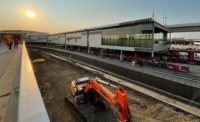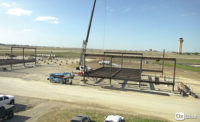ENR 2021 Top 25 Newsmakers
Khaled Naja: Fostering Modular Innovations for First-of-Its-Kind Maneuver at US Airports

Naja (far right) asks contractors for innovation when they bid on projects at DFW, which led to a first-of-its-kind modular move.
Photo courtesy DFW
When Khaled Naja was a kid, his favorite toys were Legos—but he didn’t like following instructions on how to use them.
“I found my true joy freestyling my way through endless possibilities,” says the executive vice president of infrastructure and development at Dallas-Fort Worth International Airport. “Seeing the world in components came instinctively, and over time I honed my skills in whatever I was trying to build by segmenting, creating and connecting modules.”
Related Article:
DFW Airport Module Move Is First of its Kind in the Nation
Back to:
25 Top Newsmakers
That approach to engineering coupled with years of experience at airports around the world culminated in the maneuver this fall of six prefabricated modules rolled into place to form an 80,000-sq-ft new concourse at the airport.
Delivered between Aug. 26 and Sept. 9 on self-propelled modular transporters provided by Mammoet, the modules are a first of their kind for North American airports.
The largest module weighed 550 tons and was 86 ft x 86 ft x 33 ft. Each module was prepped onto the transporter in the morning and moved that night during a six-to-eight-hour window.
The modules, complete with metal panels and glazing, were transported a quarter mile across the airfield, including a 90° turn, from the prefabrication yard to the site every other night by three modular transporters moving in parallel at up to 5 mph.
“We were able to deliver gates 25% cheaper, reduce the overall schedule by 20% and have a quality product at the end of the day,” says Naja.
The design-build team, led by Walsh Group unit Archer Western, H.J. Russell, Phillips/May and PGAL, had responded to the airport’s request for innovative solutions related to the new concourse.
“Khaled doesn’t look for contractors; he looks for partners,” says Michael Whelan, president of Walsh Group's building division. “He affords anyone on the team the opportunity to advance design and construction techniques, challenge the norm and develop solutions together.”
The High C Gates project built on Dallas-Fort Worth's previous use of modular to place new restrooms.
The next step is to place a fully fitted-out concourse in a similar fashion, says Naja. “As I watched the modules traverse under the guideway, lift 18 feet above ground, maneuver effortlessly between dozens of columns and be set within ½-inch of design tolerance, I kept thinking about my parents’ patience, my mentors’ guidance and my team’s tenacity,” he says.
Chris Arman, senior vice president of HNTB Corp., calls Naja’s approach to problem-solving “legendary,” adding that “the lens through which he views the problem and his willingness to try new approaches is revered.”
Elaine Rogers, principal at Henderson Rogers Structural Engineers, says: “It was quite refreshing to have the owner so open to new ideas and actually implementing them on such a high-profile project. The success of the project was obviously a team effort, but we must acknowledge that the achievement of all was directly a result of the leadership of DFW, and particularly of Khaled Naja.”




